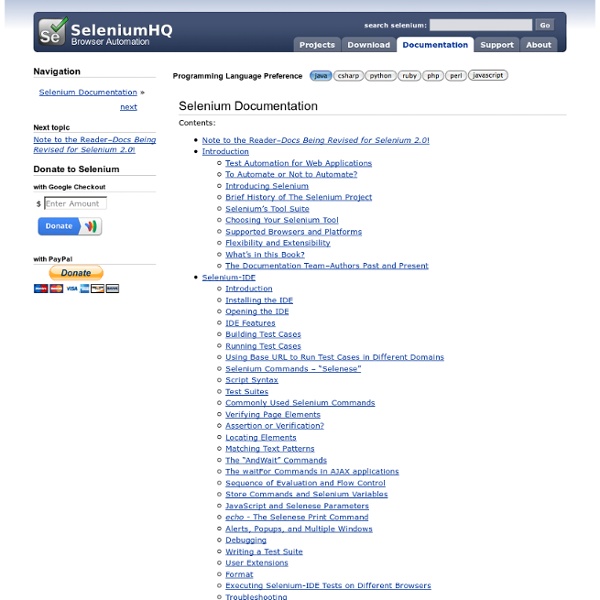



Web Testing with Selenium Sushi: A Practical Guide and Toolset How does one test the user-interface of a web application? Too often, the answer seems to be 'clumsily, slowly, and not very well'. The technology of automated, repeatable, testing of websites is still developing, but it exists; and Michael Sorens is here to describe an even better approach based on Selenium Contents Some testing categories, such as unit testing, are well-supported by tools. Broadly speaking, applications with a graphical user interface fall into two types: client applications, those that run on a user’s computer, and web applications, those that run on a remote server and are accessed with a client browser. I measure goodness in a software package by using a simple yardstick against the three aspects, features, documentation, and support. Record and playback actions (primarily typing and mouse clicks). That short but powerful list of features is one of the main reasons I became enamored with this free product. Any software package, however, has defined boundaries. try
Selenium WebDriver — Selenium Documentation NOTE: We’re currently working on documenting these sections. We believe the information here is accurate, however be aware we are also still working on this chapter. Additional information will be provided as we go which should make this chapter more solid. Introducing WebDriver The primary new feature in Selenium 2.0 is the integration of the WebDriver API. WebDriver is designed to provide a simpler, more concise programming interface in addition to addressing some limitations in the Selenium-RC API. How Does WebDriver ‘Drive’ the Browser Compared to Selenium-RC? Selenium-WebDriver makes direct calls to the browser using each browser’s native support for automation. For those familiar with Selenium-RC, this is quite different from what you are used to. WebDriver and the Selenium-Server You may, or may not, need the Selenium Server, depending on how you intend to use Selenium-WebDriver. There are some reasons though to use the Selenium-Server with Selenium-WebDriver. Java <? Python Ruby Perl
Suggested Learning Guide Selenium Tutorial Everyone wants to learn Selenium and productively use this test automation tool, but not everyone knows how to begin the journey. I will try to get you on the road to becoming a Selenium guru, starting with the basics and covering all of the core concepts you need to become vigorous in Selenium. I’m aiming Selenium tutorial at complete beginner who desires to learn Selenium from the very beginning, software professional who needs rapidly expand Selenium skills and QA Manager who eager to improve testing and coverage. How did I get started with Selenium? Selenium tutorial and documentation Selenium has a distinct advantage in terms of resources for beginners. Selenium books Selenium documentation is a great tool and it would help a lot, but recently the main resource in our team is Selenium Simplified by Alan Richardson and Selenium Testing Tools: Beginners Guide by David Burns. Getting help with Selenium Conclusion The step for learning Selenium can be summarized as follows